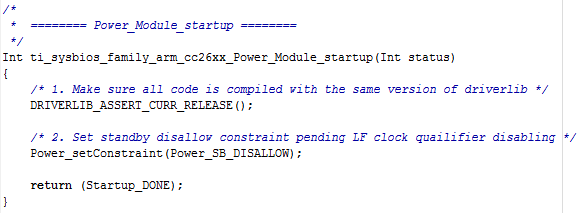SWRA486A August 2015 – April 2017 CC1310 , CC2620 , CC2630 , CC2640 , CC2640R2F-Q1 , CC2650 , CC2650MODA
- CC26x0, CC13x0 SimpleLink™ Wireless MCU Power Management Software Development
-
CC26x0, CC13x0 SimpleLink™ Wireless MCU Power Management Software Development
- 1 Abbreviations
- 2 Power Management Introduction
- 3 TI-RTOS Power Modes
- 4 Implementation Considerations
- 5 References
- Revision History
4.1.2 Initializating TI-RTOS
For more information on the device initialization by TI-RTOS, see Figure 9.
 Figure 9. TI-RTOS Initialization
Figure 9. TI-RTOS Initialization - Make sure all code is compiled with the same version of driverlib— Ensure that the TI-RTOS implementation is built with the same version of driverlib as the rest of the application.
- Set standby disallow constraint pending LF clock qualifier disabling— TI-RTOS-specific code to ensure the application enters standby after the LF clock source selected in CCFG is selected and stable. Disable the LF clock qualifiers after selecting the LF clock source.